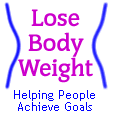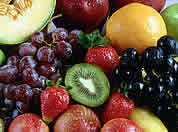
Click Your Topic
 |
 |
 |
 |
Healthy Eating Habits
Our genes affect our tendency to gain weight. A tendency to gain weight is increased when food is plentiful and when we use equipment and vehicles to save time and energy. However, it is possible to manage your weight through balancing the calories you eat with your physical activity choices.To make it easier to manage your weight, make long-term changes in your eating behavior and physical activity. To do this, build a healthy base and make sensible choices. Choose a healthful assortment of foods that includes vegetables, fruits, grains (especially whole grains), skim milk, and fish, lean meat, poultry, or beans. Choose foods that are low in fat and added sugars most of the time. Whatever the food, eat a sensible portion size. Try to be more active throughout the day. The physical activity guideline recommends that all adults get at least 30 minutes of moderate physical activity most or preferably all days of the week. To maintain a healthy weight after weight loss, adults will likely need to do more than 30 minutes of moderate physical activity daily. Over time, even a small decrease in calories eaten and a small increase in physical activity can keep you from gaining weight or help you lose weight.
Choose Sensible Portion Sizes
Control portion size. See Pyramid Food Guide for sensible sizes and numbers of servings.
- If you're eating out, choose small portion sizes, share an entree with a friend, or take part of the food home (if you can chill it right away).
- Check product labels to learn how much food is considered to be a serving, and how many calories, grams of fat, and so forth are in the food. Many items sold as single portions actually provide 2 servings or more. Examples include a 20-ounce container of soft drink, a 12-ounce steak, a 3-ounce bag of chips, and a large bagel.
- Be especially careful to limit portion size of foods high in calories, such as cookies, cakes, other sweets, French fries, and fats, oils, and spreads.
The carbohydrates, fats, and proteins in food supply energy, which is measured in calories. High-fat foods contain more calories than the same amount of other foods, so they can make it difficult for you to avoid excess calories. However, low fat doesn't always mean low calorie. Sometimes extra sugars are added to low-fat muffins or desserts, for example, and they may be just as high in calories.
Your pattern of eating may be important. Snacks and meals eaten away from home provide a large part of daily calories for many people. Choose them wisely. Try fruits, vegetables, whole grain foods, or a cup of low-fat milk or yogurt for a snack. When eating out, choose small portions of foods. If you choose fish, poultry, or lean meat, ask that it be grilled rather than fried.
Like younger adults, overweight and obese older adults may improve their health by losing weight. The guidance of a health care provider is recommended, especially for obese children and older adults. Since older people tend to lose muscle mass, regular physical activity is a valuable part of a weight-loss plan. Building or maintaining muscle helps keep older adults active and reduces their risk of falls and fractures. Staying active throughout your adult years helps maintain muscle mass and bone strength for your later years.
If you need to lose weight, do so gradually
If you are overweight, loss of 5 to 15 percent of your body weight may improve your health, ability to function, and quality of life. Aim to lose about 10 percent of your weight over about 6 months. This would be 20 pounds of weight loss for someone who weighs 200 pounds. Loss of 1/2 to 2 pounds per week is usually safe. Even if you have regained weight in the past, it's worthwhile to try again.
Encourage healthy weight in children
Children need enough food for proper growth, but too many calories and too little physical activity lead to overweight. The number of overweight U.S. children has risen dramatically in recent years. Encourage healthy weight by offering children grain products; vegetables and fruits; low-fat dairy products; and beans, lean meat, poultry, fish, or nuts—and let them see you enjoy eating the same foods. Let the child decide how much of these foods to eat. Offer only small amounts of food high in fat or added sugars. Encourage children to take part in vigorous activities (and join them whenever possible). Limit the time they spend in sedentary activities like watching television or playing computer or video games. Help children to develop healthy eating habits. Make small changes. For example, serve low-fat milk rather than whole milk and offer one cookie instead of two. Since children still need to grow, weight loss is not recommended unless guided by a health care provider.
Serious eating disorders
Frequent binge eating, with or without periods of food restriction, may be a sign of a serious eating disorder. Other signs of eating disorders include preoccupation with body weight or food (or both—regardless of body weight), dramatic weight loss, excessive exercise, self-induced vomiting, and the abuse of laxatives. Seek help from a health care provider if any of these apply to you, a family member, or a friend.
Advice for Eating Healthy
- Aim for a healthy weight. If you are at a healthy weight, aim to avoid weight gain. If you are already overweight, first aim to prevent further weight gain, and then lose weight to improve your health.
- Build a healthy base by eating vegetables, fruits, and grains (especially whole grains) with little added fat or sugar.
- Select sensible portion sizes.
- Get moving. Get regular physical activity to balance calories from the foods you eat.
- Set a good example for children by practicing healthy eating habits and enjoying regular physical activities together.
- Keep in mind that even though heredity and the environment are important influences, your behaviors help determine your body weight.
"3 Habits to Lose Weight: Nutrition, Exercise, Lifestyle"
Information presented on Lose Body Weight website is considered public information. This website is for informational and educational purposes only. The information provided is not intended as a substitute for the care of a doctor or medical professional. If you suspect that you have a health problem, we urge you to contact your physician or local hospital for care. Weight Loss ideas are not proven.